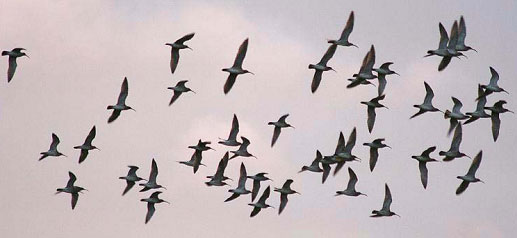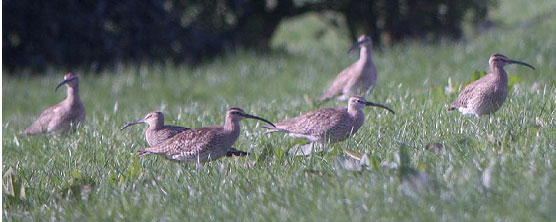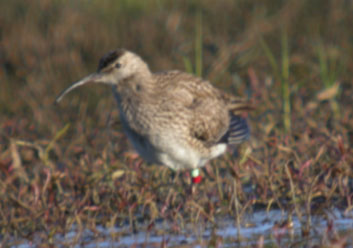During April and May large numbers of Whimbrels migrate from their West African wintering grounds and pass through Europe before settling to breed in Iceland, Scandinavia, the Faroes and Shetland.
In England a noticeable easterly passage is usually reported during sea watching sessions at points along on the south coast. Some of these birds may well be Scandinavian breeders on their way to re-fuel in the Low Countries. Elsewhere, northbound individuals and flocks may be seen resting for a few hours at almost any coastal, lake or reservoir site. Finally, some of the migrating Whimbrels make an extended stay to re-fuel at one of the 16 or so traditional staging grounds. Each staging ground has a secure roost site close to open water surrounded by invertebrate rich permanent pastures.

Whimbrel: Whimbrel arriving at the Brockholes Quarry roost site after feeding on pastures in central Lancashire (photo: Bill Aspin).
In the 1970s the main staging ground was found in Somerset when over 2000 Whimbrels fed on the Levels during the day and roosted at Stert Island. However, as the water table under the pastures was lowered the available food supply diminished and the numbers of staging Whimbrel declined by 90%.

Whimbrel: A typical view of Whimbrel feeding on pastures (photo: Bill Aspin).
Currently, the main staging grounds are found close to the south and east coasts from Devon to Norfolk and at inland sites in Lancashire and Yorkshire. Regular roost counts have been made at several of these staging grounds for many years. Maximum counts at some of the largest roost sites such as Barnacre (Lancashire), Rye (Sussex) and Wheldrake Ings (North Yorkshire) peaked in the mid 1990s and since then numbers have fallen by between 25% and 40%.
A major study of the Whimbrel staging ground in the Lower Derwent Valley, south east of York, began in 2004. 6 Whimbrels have been radio-tagged allowing the extent and nature of the feeding grounds to be determined as well as giving an indication of the length of stay of individual birds. One bird, known as ‘Wally’, was satellite-tagged in 2005 and her journeys during the following twelve months are reported on www.whimbrel.info.

Whimbrel: Colour-ringed Whimbrel at Wheldrake Ings (photo: Dave Tate).
Twenty-seven Whimbrels have been colour ringed – the right leg has a colour ring above the knee and a metal BTO ring below; on the left leg there are 2 colour rings above the knee and one below. Colour ringing further helps to establish the length of stay of individual birds as well as giving the opportunity for re-sightings in subsequent years. Off site re-sightings have yet to be reported however, 7 of the 11 birds colour ringed in 2005 returned to the Lower Derwent staging area in 2006. If you see any coloured ringed birds please report your findings to Todavetate@aol.com. In return you will receive a life history of the bird and your data will be forwarded to the BTO. Also, any counts, information or photographs relating to staging sites will be greatly appreciated.
Further research will take place in the Lower Derwent Valley this year. Additional satellite and radio-tags are available and ongoing updates will be posted on the Whimbrel web site.

